
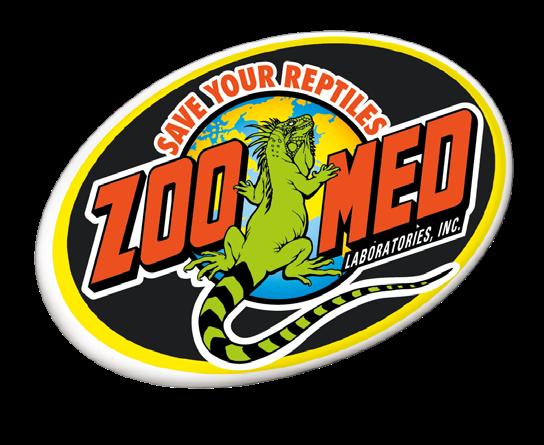



By: Miranda S. Huntley



Bearded dragons are debatably the best pet reptile. They’re inquisitive, calm, and incredibly adorable, which has caused them to be the longstanding heartthrob of the reptile world for beginners and experienced keepers alike. Once you see a bearded dragon ferociously chase down a mealworm or affectionately accept chin scratches, you’ll understand why they’re such beloved pets. This book is intended to be the first step in educating yourself about the basics of selecting, setting up, and maintaining your pet bearded dragon.

Bearded dragons are intelligent reptiles that seem to enjoy interacting with their keepers. With frequent handling, you can easily pick them up and pet them. Raising a bearded dragon can be rewarding, and while they make excellent pets for any level keeper, it's important to thoughtfully decide if one is the right pet for you and your lifestyle. Here are a few key things to consider:
• Bearded dragons grow to be large lizards that need to be handled regularly to maintain their docile nature. These are strong animals that may not be appropriate for young children. Regardless, always supervise children around bearded dragons.
• Due to their large size as adults (16-24" or 40-60 cm), bearded dragons require bigger enclosures than some other reptile species.
• Bearded dragons are omnivores that need a varied diet of insects, vegetables, greens, and a small amount of fruit − and their diet changes with age from insect-heavy to plant-heavy. Dragon Food pellets can help simplify their complex dietary needs.
• These desert-dwelling lizards need specialized heat and lighting to stay happy and healthy, so they require more equipment than some other reptile species.
• Bearded dragons can live up to 15 years and need a keeper ready for a long-term commitment.
• Always wash your hands after interacting with your bearded dragon or its habitat. All reptiles, including bearded dragons, can potentially carry Salmonella. By maintaining good hygiene, you can ensure a safe and enjoyable experience with your pet.

Learning about your reptile's natural habitat can provide insight into their proper care.
Australia is home to several species of bearded dragons, but the most popular one kept as a pet is the central bearded dragon (Pogona vitticeps). They typically live in sandy, arid environments ranging from Australia's southern coastal dunes into the hot Australian outback. In the wild, they're often seen basking on elevated rocks and branches, seeking a high vantage point to view prey, mates, and predators while soaking in the Sun. During the hottest parts of the day, they often seek shelter by retreating into shade or digging deep into the ground.



Map of Australia. The highlighted blue region is the natural range of the central


Wild central bearded dragons (P. vitticeps) in their natural environment. Basking on sandy substrate (A), elevated rocks (B), and branches (C). Seeking shelter in the shade (D).
Tail: A bearded dragon's tail makes up almost half of its body length! The tail is used for balance, communication, and defense. Unlike some other reptiles, bearded dragons do not drop and regenerate their tails.
Nostril: Bearded dragons can breathe and smell through their nostrils, however, this is not the primary way they smell.

Jacobson’s Organ (not pictured):
The Jacobson’s organ is the primary site of smell for reptiles, located on the roof of their mouths. Reptiles stick out their tongue to gather scent particles to bring to the Jacobson’s organ.
Parietal "Eye": This is a simple "eye" that is not involved in image-forming vision. Instead, it only senses light and is thought to be involved in setting the “internal clock”.
Eye: Bearded dragons have amazing vision! Their eyes are located on the sides of their head, allowing for a wide view. Wild-type bearded dragons have a lightly colored iris contrasted by a black pupil, but some morphs have solid black eyes.

The arrow points to a bearded dragon’s parietal eye.

Ear: Bearded dragons do not have earlobes, they simply have indentations on the sides of their head that lead to the ear canal.
Lateral Fringe: The long, spiky scales on the side of their bellies are intimidating to predators. Some scientists think they may also help with temperature regulation.
Gular Fringe (Beard): The long, spiky scales along their neck resemble a beard and serve similar purpose as the lateral fringe. The beard, together with the saggy skin on their jaws (gular pouch), can expand and darken in color to make the dragon appear larger to predators and potential mates.
Vent: Reptiles have a single opening for reproduction and excreting waste.
It’s a good idea to have everything you need to set up your habitat before taking home a bearded dragon. A starter kit designed for bearded dragons is a great way to ensure you have the basics to get started!

ITEM# NT-B22
30"x12"x12" (76x30x30 cm)


ITEM# NT-B40
36"x18"x18" (91x46x46 cm)
Most bearded dragons sold in pet stores are juveniles that will need, at minimum, a 20-gallon long terrarium (30"x12"x12"; 76x30x30 cm). While they eventually outgrow this size habitat, some juveniles can have difficulty finding food, thermoregulating, and feeling secure in a larger enclosure. Adult bearded dragons need a 40-gallon breeder terrarium (36"x18"x18"; 91x46x46 cm), at minimum.
Some keepers prefer terrariums with front-opening doors. These habitats allow easy access to your dragon without disturbing the lighting and heating equipment above the enclosure. Our front-opening, double-door terrariums are available in 25-gallon and 40-gallon sizes and are suitable for juvenile and adult bearded dragons, respectively.

DOUBLE DOOR REPTIHABITAT™ - 25 GALLON
ITEM# NT-25DW
30"x12"x16" (76x30x30 cm)

DOUBLE DOOR REPTIHABITAT™ - 40 GALLON
ITEM# NT-40DW
36"x18"x18" (91x46x46 cm)
Bearded dragons live in arid, sandy places in the wild and will do well on various types of substrates in captivity. However, newly acquired juvenile bearded dragons may do best on cage carpets.
A naturalistic substrate is ideal for well-established juveniles and adults in order to support natural digging behaviors. Excavator® Clay Burrowing Substrate is a fun option that allows you to create an enriching, naturalistic habitat. It comes powdered, but when mixed with water, it transforms into a moldable clay that hardens once dry. You can keep it simple by layering it on the bottom of your enclosure, or get creative by building burrows or ledges for basking.
ReptiSand®, ReptiFresh®, and ReptiSoil™ are other naturalistic options that allow for digging. Mix any combination of these substrates (including Excavator® Clay in its powdered form) for a custom blend. Be sure to maintain deep, moist substrate in a section of the habitat for gravid ("pregnant") females. Without access to suitable egg-laying substrate, they may retain eggs, which can be a serious health issue. Some keepers like a separate nesting box that can be added or removed from the enclosure when needed. Note: Females can still lay eggs without ever having been with a male.







EXCAVATOR® CLAY BURROWING SUBSTRATE ITEM# XR-20







When housing reptiles indoors, it’s essential to provide specialized heating and lighting to help recreate critical aspects of the Sun’s spectrum: infrared (heat), visible light, and ultraviolet light.

The part of the Sun's Electromagnetic Spectrum that is useful to reptiles can be broken down into 3 parts: ultraviolet light, visible light (what humans can see), and infrared.
Infrared is the part of the Sun’s spectrum that we feel as heat. Reptiles have unique heat requirements because they are ectothermic, meaning the external environment controls their body temperature. Reptiles regulate their body temperature (thermoregulate) by moving to warmer and cooler locations throughout the day. Therefore, it's essential to provide a thermal gradient (warm area, cool area, and a daytime elevated basking area) within your enclosure. Your dragon will instinctively thermoregulate; you just need to provide a proper thermal gradient for them! The diagram below shows an appropriate daytime heat gradient for a bearded dragon.

Daytime Basking Area: 95-105°F
Daytime Ambient Temperature: 75-90°F
Nighttime Ambient Temperature: 70-80°F
When choosing which daytime heat sources to use, it helps to remember that your goal is to recreate natural sunlight as best as possible. The Sun produces three types of infrared: infrared-A (IRA), infrared-B (IRB), and trace amounts of infrared-C (IRC). IRA is considered “basking heat”, IRB is great for warming substrate for nesting sites, and IRC is considered “ambient heat” that maintains stable air temperatures.
The different types of infrared have different physiological results. IRA is a shorter, energy-rich wavelength that penetrates deep and stimulates blood circulation, increases oxygen flow, and boosts metabolism. If IRA is not provided by a daytime basking heat source, reptiles are more susceptible to illness and may not efficiently heal from injuries and infections. Therefore, IRA is the most important part of the infrared spectrum when it comes to daytime basking.
Since IRA makes up most of the infrared portion of sunlight and has critical physiological effects, it’s important to choose a daytime basking bulb that provides this. There is no other heat source other than incandescent filament bulbs that produce appropriate amounts of IRA. The Repti Basking Spot Lamp, ReptiTuff Halogen bulbs, and PowerSun® UV, are excellent choices for heating the basking area during the day.





For large habitats, additional ambient heat sources might be needed. The ReptiCare® Infrared Heat Projector is a great supplemental heat source during the day. Many breeders recommend using heat projectors to warm the substrate in nesting sites. The ReptiCare® Ceramic Heat Emitter is great for day and night (24 hour) supplemental heating to maintain stable air temperatures.
A temperature drop at night is natural, but the terrarium's temperature should not dip below 70°F. In many cases, you will need to provide a 24-hour heat source that emits little or no visible light. Several good options are the ReptiCare® Ceramic Heat Emitter, ReptiCare® Infrared Heat Projector, Nocturnal Infrared Heat Lamp, and ReptiTherm® Undertank Heater.

REPTICARE® CERAMIC INFRARED HEAT EMITTER
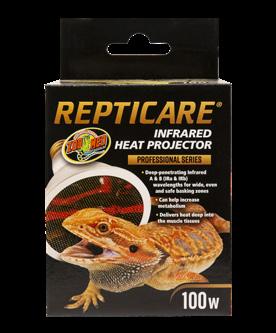
REPTICARE® CERAMIC INFRARED HEAT EMITTER

NOCTURNAL INFRARED HEAT LAMP


REPTITHERM UNDER TANK HEATER
Note: The correct wattage for your enclosure will vary based on the temperature of the room it is located in. Not all enclosures of equal size will require the same wattage bulb to maintain appropriate temperatures. Therefore, you should always monitor temperatures and adjust accordingly.
Note: The ReptiCare® Ceramic Heat Emitter needs to be used in the Zoo Med's Wire Gage Clamp Lamp. Do not use in an enclosed "dome" fixture.


It's essential to monitor the temperatures in your enclosure with at least one thermometer. The High Range Reptile Thermometer and the Precision Analog Thermometer can be stuck to the wall inside your terrarium on the warm and/or cool side to monitor ambient temperatures. Digital thermometers with a probe can also be used to monitor ambient temperature but are perfect for specific spots in your enclosure, like the basking area. A customer-favorite probe thermometer is the Min-Max Thermometer because it displays the current temperature and records highs and lows, allowing you to monitor temperature fluctuations when you are not around. It is especially useful for identifying nighttime temperature drops or heat spikes during the day that may need to be addressed.

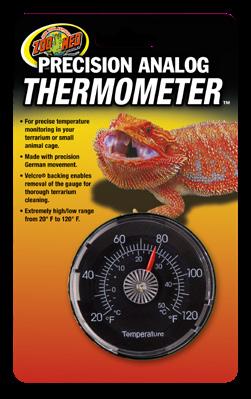



Reptiles have excellent color vision, so your habitat must have adequate lighting. It’s important to know that what we see as visible light differs slightly from reptiles: most reptiles have a fourth color-sensing receptor in their eye that allows them to see UVA light. While humans cannot see UVA light, reptiles are partially colorblind if proper UVA is not provided!

Visible light and UVA are important for your bearded dragon’s physical and mental health. It helps them navigate their environment, recognize food, and set their “internal clock”. Specifically, day length (photoperiod) helps set their internal clock. In nature, a photoperiod is determined by the Sun's rising and setting, but this must be managed when housing reptiles indoors. To replicate a natural photoperiod, provide visible light for 10-14 hours during the daytime. UVB lamps also provide visible light and UVA. Many heat bulbs also provide visible light but may not include UVA or UVB, so be sure to read product descriptions carefully.
UVB is part of the Sun’s natural spectrum, but is not visible to humans or reptiles. UVB is one of the most critical parts of the spectrum when keeping your bearded dragon indoors. Together, UVB lighting and heat are essential for bearded dragons housed indoors to make their own vitamin D3, which allows them to process calcium from their diet. Some reptiles can get adequate vitamin D3 from their diet, but this is not the case for bearded dragons. Without UVB lighting, bearded dragons will develop serious health problems like Nutritional Metabolic Bone Disease, often referred to as just "MBD". In short, MBD results in inappropriate calcium absorption and can cause crippling bone deformities. MBD is one of the most common health problems pet bearded dragons experience. Thankfully, MBD is preventable by providing UVB and a proper diet.

Many options are available for reptile keepers to provide UVB to their animals. To determine the best bulb for your setup, consider 1) the height of your enclosure, 2) your animal's Ferguson Zone, and 3) the distance from the UVB light source to the basking area. Bearded dragons are midday baskers (Ferguson Zone 4), meaning their elevated basking area should have a UVI reading of 2.6 to 3.5+. The following chart has a selection of UVB bulbs with their UVI readings at different distances to help you choose the best bulb and basking area location for your bearded dragon set-up:
What is a Ferguson Zone?
Ferguson Zones are determined by observing a reptile’s basking behavior in its natural environment and recording the UV Index (UVI) the reptile experiences during basking. This research was initially done by Dr. Gary Ferguson, so the zones were named in his honor.

Popular UVB sources for a 12” tall, 20-gallon juvenile enclosure:


REPTISUN® 5.0 CLF ITEM# FS-C10M

REPTISUN® 5.0 T5 LINEAR POWERSUN UV - 80W ITEM# PUV-12

Popular UVB sources for an 18” tall, 40-gallon enclosure:

REPTISUN® 10.0 CLF ITEM# FS-C5


REPTISUN® 10.0 T5 LINEAR POWERSUN UV - 100W ITEM# PUV-11

UVB lights will slowly diminish their UVB output over time. Even if they're still emitting visible light, they may not be emitting UVB, so replacing bulbs according to manufacturer's instructions is crucial. Zoo Med's line of UVB bulbs produce usable UVB for 1 year before needing to be replaced. One exception is the ReptiSun® UVB/LED that was designed to produce usable UVB for 4 years!
Habitat automation is a great way to maintain a consistent day-night schedule, which is essential for the well-being of your pet. Several tools are available for day-night automation, as well as precise temperature control. Zoo Med's Environmental Control Center offers complete habitat automation. It has two thermostats, one humidistat, and three timers all in one device. To automate just one aspect of your pet's environment, we have several timers and a thermostats that can help.

ENVIRONMENTAL CONTROL CENTER
ITEM# RT-1000

REPTICARE® DAY NIGHT TIMER ITEM# LT-10

REPTICARE® TERRARIUM CONTROLLER ITEM# LT-12

REPTITEMP® DIGITAL THERMOSTAT ITEM# RT-600
Adding décor can be the best part of setting up a habitat! It's fun to pick out pieces and personalize your pet's habitat. However, it's also important to pick functional pieces that best serve your pet by considering their body size, basking habits, shelter preferences, and climbing abilities.
For bearded dragons, we recommend having hiding places on both the cool and warm sides of your habitat using Habba Huts and/or Natural Cork Rounds. Provide an elevated basking area that comfortably supports the animal’s entire body. Thick branches, rocks, Mopani Wood, and Cork Flats are excellent choices for climbing and basking. Sand-Blasted Grapevine is another great choice for juveniles but may be too thin for adults.
Naturalistic Desert Flora can be the perfect finishing touch to your habitat, but it should be added with supervision as bearded dragons are omnivores and may attempt to eat some.










Always provide a clean water dish with fresh water to prevent dehydration. Juveniles should have a shallow water dish, while adults should have a deeper dish. Repti Rock Dishes are great for this. Always treat tap water with ReptiSafe® Water Conditioner.
Not all bearded dragons will drink from their habitat’s water dish and can become dehydrated if alternatives are not offered. Lightly misting the enclosure can encourage drinking and support hydration but is optional, especially in humid climates. A shallow, 10-20 minute warm water bath once a week can help hydrate your bearded dragon. Zoo Med’s Reptile Electrolyte Soak with probiotics is an excellent addition to the water during a bath to help support hydration and digestion. Be sure to supervise your bearded dragon during baths to ensure it is comfortable with the water level and that the temperature remains between 90-98°F. A warm bath can encourage bowel movements, so refresh the water if needed. After the soak, pat your bearded dragon dry and place it in its basking area.








1. Naturalistic Terrarium® Double Door - 40 Gallon

2. Digital MIN-MAX Precision Thermometer

3. Combo Deep Dome Dual Lamp Fixture
4. ReptiCare® Infrared Heat Projector - 60 watt
5. Repti Tuff™ Splashproof Halogen Lamp - 90 watt



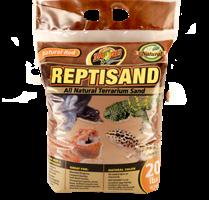


8. Precision Analog Thermometer & Humidity Gauge™


9. ReptiSun® T5 HO Terrarium Hood - 36"





Bearded dragons are omnivores that eat both plants and insects at all stages of their lives, but in different proportions as they age. Juveniles require an insectheavy diet, while adults require a plant-heavy diet.
In this section we will help you build a foundation of knowledge that will allow you to provide your dragon a well-rounded diet. In short, a pet bearded dragon’s diet can be broken down into “salad plates”, insects, and nutritional supplements.
The salad plate is a staple part of a pet bearded dragon's diet. Typically, the salad plate is used to fulfill the vegetarian part of their diet and consist of a mix of greens and vegetables. However, you can also mix in canned insects and fortified pellets to make it a wellrounded meal.

Your bearded dragon’s salad plate does not have to look the same every time. In fact, it’s best to provide variety whenever possible! A varied diet is not only enriching to your bearded dragon, but allows foods to complement each other, filling in nutritional gaps and ensuring your dragon gets what they need over time. Our typical, go-to salad plate is made of greens, vegetables, and Zoo Med's Dragon Food. Juveniles should get a fresh salad plate daily, while adults can be given a fresh plate every other day.
• Thoroughly wash to remove dirt
• Roughly chop for adults, shred into small pieces for young juveniles
• Sprinkle with ReptiVite™ or Repti Calcium® as needed
Staple Greens
Dandelion Greens
Mustard Greens
Endive/Escarole
Arugula Clover
Romaine Lettuce Spring Mix
Staple Vegetables Fruits (in moderation) Avoid (toxic)
Carrots Zucchini
Bell Peppers Squash
Green Beans

Mango Banana Berries
Apples Tomato
Papaya
Avocado Onions Rhubarb
Citrus Fruit Fireflies
Zoo Med's Dragon Food is the result of three years of research and development. The diet helps to streamline feeding, fill nutritional gaps, and is tailored to bearded dragons’ agespecific needs. Dragon Food was formulated as a complete diet and can be fed by itself on busy days or by a pet sitter while you’re on vacation. However, its best used on a regular basis mixed into your bearded dragon’s salad plate. Using Dragon Food can give you peace of mind that your bearded dragon receives the nutrients they need.

JUVENILE DRAGON FOOD ITEM# ZM-274

ADULT DRAGON FOOD ITEM# ZM-278
• Made with bearded dragon-favorites like clover and dandelion greens, calcium-rich black soldier fly larvae, and a small amount of mango.
• Helps promote gut health with added probiotics and long-stem fiber (coarsely chopped Miscanthus grass).
• Made with NO artificial colors, flavors, preservatives, wheat, or soy.
• Uses green banana flour to replace the need for wheat. This novel pet food ingredient is minimally procesed and doesn’t have trace pesticides commonly found in wheat. The bananas are harvested and processed before their starches are converted to sugar, so the overall sugar content is very low.
For added variety, mix in canned insects and dried flowers, with fruit as an occasional treat:
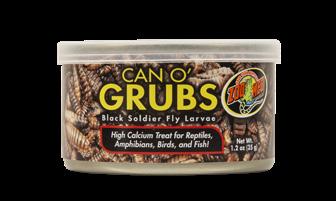



CAN O' GRUBS ITEM# ZM-155
CAN O' MINI CRICKETS™ ITEM# ZM-43
CAN O' MINI MEALIES™ ITEM# ZM-47
CAN O' SUPERWORMS™ ITEM# ZM-146




CAN O' COCKROACHES™ ITEM# ZM-147
CAN O' CRICKETS™ ITEM# ZM-41
CAN O' WORMS™ ITEM# ZM-42
TROPICAL FRUIT MIX-INSPAPAYA ITEM# ZM-151

LIZARD FLOWER FOOD TOPPER
ITEM# ZM-143, ZM-144, ZM-145

Insects are an essential part of your bearded dragon's diet as they are the primary source of protein. Insects make up a larger portion of a growing juvenile's diet compared to adults because protein is vital for growth.
There are many commercially raised insect options available (crickets, roaches, worms, grubs, etc.). Most can easily be bought live, which are great for encouraging exercise and to stimulate natural hunting behaviors. Shelf-stable canned options are available as well for tong feeding and for adding variety to your dragon’s salad plate, as mentioned previously. Most insects need vitamin and mineral supplements before they are fed to your reptile (more details on this in the supplement section). Make sure insects are appropriately sized by checking that they are no larger than the space between your bearded dragon’s eyes. We recommend offering young juveniles insects daily, but decreasing the frequency as they age. Adults should only have crickets 1-2 times a week.
Gut-loading is when insects are fed a specially formulated diet to increase their calcium content before they are fed to reptiles. While calcium is the focus of gut loading, many diets also include other trace nutrients like Vitamin A, E, D, and C.



Crickets are a great staple insect for bearded dragons. They are high in protein, low in fat, and move quickly so are ideal for encouraging exercise. Crickets are available at most pet stores in a range of sizes that will work for your dragon’s different life stages.
Dubia Roaches are another great staple feeder. Like crickets, they are high in protein and low in fat. These roaches have a better calcium content than crickets, but it is not significant enough to completely omit Repti Calcium® dusting. Recently, these have become more available at pet stores.
Mealworms are available at most pet stores in multiple sizes. These are bearded dragon favorites that are a good source of protein, but are high in fat so should be fed in moderation, especially to adults that are prone to obesity.
Superworms look like gigantic mealworms, but are actually a different species! These are a beloved high protein treat, but are high in fat and very low in calcium so should be fed in moderation and always dusted in Repti Calcium®. Ensure these are an appropriate size for your dragon before feeding.
Black Soldier Fly Larva are unique feeder insects because they are naturally high in calcium so do not require ReptiCalcium® dusting. They are also a great source of protein, but can be high in fat, which is why Dragon Food uses defatted black soldier fly larva.
Hornworms are loved by bearded dragons and a great source of hydration. You may see these in your tomato garden, but their wild diet contains toxic compounds to bearded dragons. Commercially raised hornworms are fed a diet free of these toxic compounds and are perfectly safe to feed. Due to their high moisture content, they are best fed in moderation to prevent loose stools.
Wax Worms are high in fat and low in protein compared to other available feeder insects, so should only be fed as an occasional treat.
Butterworms despite their name, are not very high in fat. However, their protein and calcium levels are relatively low. Therefore, these should only be fed as an occasional treat.
Maintaining an adequately balanced diet for pet reptiles can be challenging, especially regarding micronutrients (i.e., vitamins and minerals). Each dietary item is unique and feeding a varied diet allows foods to complement each other and help fill nutritional gaps. While this strategy is helpful, it is not a perfect solution because most of the insects, greens, and vegetables we have available to feed our pet reptiles are inadequate compared to what reptiles eat in the wild. Therefore, vitamin and mineral supplements are often necessary to sufficiently balance the diet.
A broad multivitamin and mineral supplement, like ReptiVite™, can be used up to once a week to correct most micronutrient imbalances. In addition, a separate phosphorus-free calcium supplement, like Repti Calcium®, will need to be used more frequently. These supplements are available with and without added vitamin D3. For bearded dragons with adequate UVB exposure, we recommend keepers use ReptiVite with D3 and ReptiCalcium without D3.


There are many ways to feed a well-rounded diet, this is an example of one possible schedule to follow based on years of experience raising bearded dragons.
Monday Wednesday Friday Salad plate
• Juvenile Dragon Food
• Greens
• Vegetables
• Canned insects (optional)
• Supplements (as needed)
Insects
• Live or canned insects
Tuesday Thursday
Saturday Sunday

• Live insects
• Top off plate, if empty
• Live or canned insects
• Top off plate, if empty
Salad plate
• Adult Dragon Food
• Greens
• Vegetables
• Flowers (optional)
• Canned insects (optional)
• Supplements (as needed)
• Live insects
• Flowers (optional)
• Treat (optional): whole lettuce leaf, small amount of fruit, flowers, several insects

One of the reasons bearded dragons make great pets is because of their behavior! Bearded dragons are usually calm, friendly, and easy to handle. They also exhibit some fascinating behaviors:
Bearded dragons have a relaxed posture while basking but stay alert and keep their head elevated. Sometimes, they'll open their mouth to help regulate their body temperature. However, if your dragon has its mouth open on the cool side of the habitat, it may be trying to cool down. This could indicate its habitat is too hot, so the temperatures should be checked.
Brumation is similar to hibernation: it is a state of inactivity during a period of low temperatures and short daylight hours. In the wild, bearded dragons brumate in the winter when their environment gets cold and resources become scarce.


Some pet bearded dragons may choose to brumate even if the habitat temperatures and visible light hours are unchanged. In these cases, they will cool themselves down by avoiding the basking area and spend most of their time in hides on the cool side of the enclosure. During brumation, bearded dragons sleep a lot and often stop eating. Since inactivity and lack of appetite can also be signs of illness, it's essential to monitor your dragon and seek veterinary help if needed.
Head bobbing is a sign of dominance. This behavior is most common in adult males, especially during breeding season. Head bobbing intimidates other male dragons and attracts a female dragon's attention. It's undeniable that bearded dragons' cutest behavior is the arm wave. This behavior is most common in juveniles and some female adults but is rarely seen
in adult males. As a keeper, it is tempting to misinterpret this behavior as your dragon waving hello, but it's actually their way of communicating submission. A female bearded dragon will submit to a male bearded dragon, and smaller males will submit to more dominant males. They can also use this waving to indicate to predators they see them and cannot be surprised or ambushed.
Juvenile bearded dragons’ small size makes them easy prey in the wild, so their instinct is to run whenever they sense potential predators. They may also attempt scare tactics by opening their mouth wide and using posture to look intimidating.
Adult bearded dragons use scare tactics as their primary defense and as a way to communicate they are threatened or upset. Typical defense communication includes opening their mouth wide, puffing their spikey beard, inflating their body wide, and turning darker (usually on their beard and tail tip).



If your dragon is displaying these behaviors, use caution. Although bearded dragons rarely bite, they are more likely to do so when displaying these defensive behaviors.
1. Check on your bearded dragon every day, look for health and behavioral changes that may need to be addressed.
2. Make sure the water dish is clean and filled with fresh, dechlorinated water.
3. Lightly mist the enclosure, if needed.
4. Check thermometers to confirm temperatures are correct and adjust heat lamps, if needed. If using the Min-Max Thermometer, clear data.

A clean cage will keep your pet comfortable and help prevent diseases.
1. Spot clean as needed, removing any stools, shed, and uneaten spilled food.
a. If using a fine, sandy substrate, a sifting scooper is a great tool to speed up the process!
2. Disinfect water and food dishes once a week using Wipe Out 1 Disinfectant, Cleaner, & Deodorizer.
3. Replace loose substrates entirely every 6 months, or as needed. At this time, clean and disinfect the tank and non-porous décor items using Wipe Out 1 Disinfectant, Cleaner, & Deodorizer.
a. Excavator Clay is naturally antimicrobial, so does not need to be fully replaced. Just spot clean, sweep down with a wide paintbrush, and use a wet paper towel to remove stubborn debris. Excavator Clay will erode over time, but is easy to touch up as needed.
4. For a clear view into your habitat, use the non-toxic Wipe Out Glass Cleaner as needed.
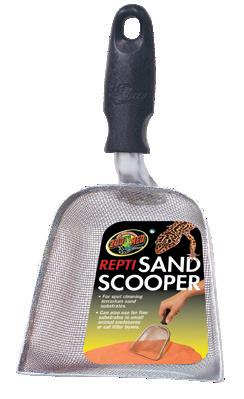


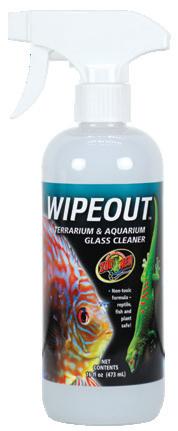
to
Find a Reptile vet near you: www.arav.org

Reptiles have unique health concerns that a standard vet often cannot address. However, veterinarians with reptile experience can be hard to find in many areas, so we recommend locating a reptile vet before you need one in an emergency. To find a reptile vet near you, use the QR code to visit the Association of Reptile and Amphibian Veterinarians’ website.
Keeping your tank clean, feeding an appropriate diet, and providing proper heating and lighting can prevent many health issues. Common health problems bearded dragons can experience that may require veterinary treatment are nutritional metabolic bone disease (MBD), infections, intestinal parasites, malnutrition, and dehydration. Unusual stools, unintended weight loss, bone deformities, labored

breathing, lethargy, and lack of appetite are common symptoms of illness that will likely require veterinary attention.
Many keepers like to schedule annual veterinary exams as part of their preventative care. During yearly exams, they will usually inspect the bearded dragon’s body condition, test a stool sample for parasites, check the UVI output of your UVB bulb, and offer care advice based on their exam and your described husbandry practices.
We hope you enjoyed this introductory guide to bearded dragons and feel more prepared to take home a beloved scaly friend of your own. While this book covers the basics, we encourage further research. You may want to learn more about the different bearded dragon "morph" colors, breeding and incubation, or how to raise your own feeder insects. Many books, magazines, and online articles are devoted to these subjects and others. Here are a few resources to help start your further research:
• Bearded Dragon Manual, 3rd Edition: Expert Advice for Keeping and Caring For a Healthy Bearded Dragon by Philippe De Vosjoli.
• Subscribe to Reptiles Magazine: A digital and print magazine devoted to the reptile and amphibian pet hobby, specializing in the keepIt is also an excellent resource for updates on reptile and amphibian scientific research (including new species discoveries!) and conservation efforts. https://reptilesmagazine.
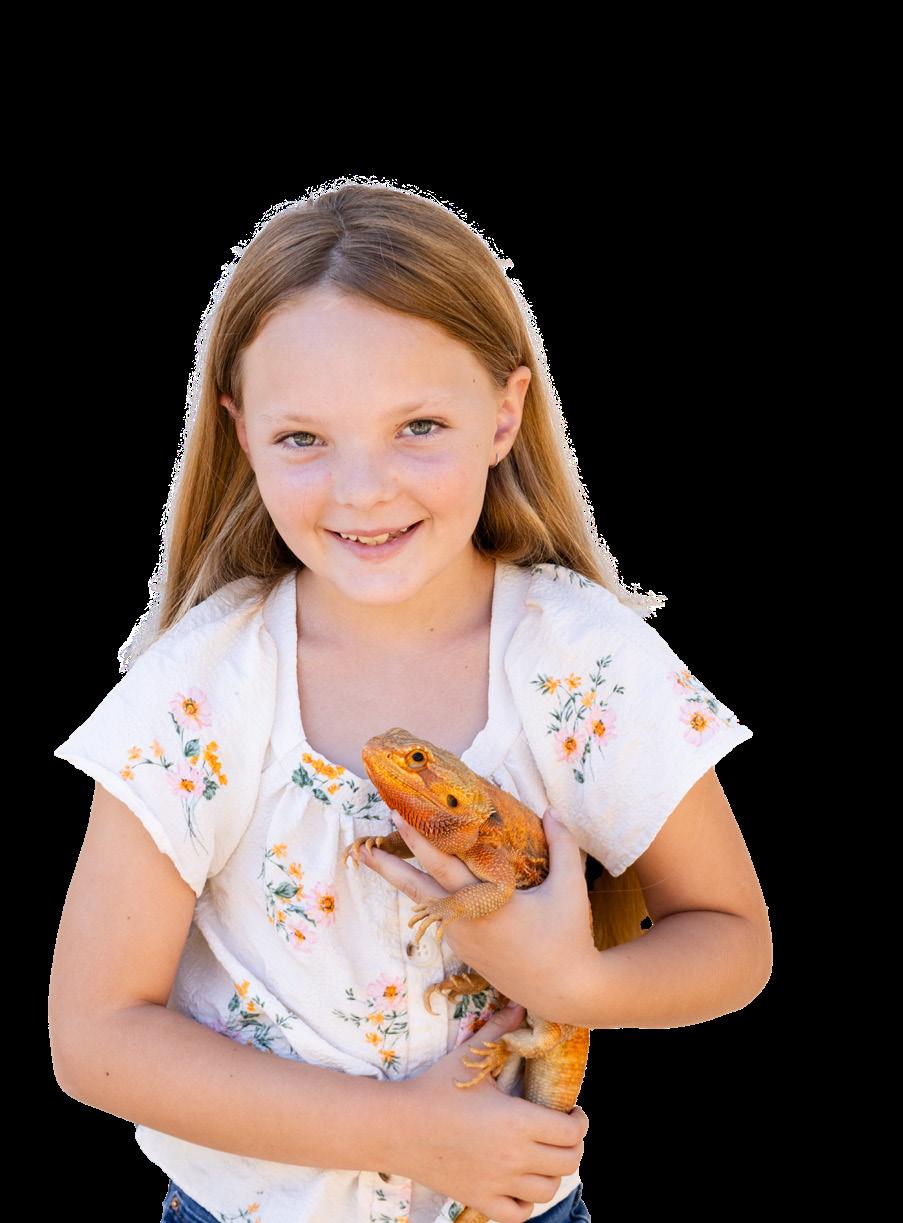
Subscribe to Exotics Keeper Magazine: A digital and print magazine all about exotic animals in captivity and the wild. Read about advancements in exotic animal care, conservation efforts, and zoo news, including interviews and expert opinions. The magazine's stunning photos are reason enough to subscribe. exoticskeeper.com
United States Association of Reptile Keepers (USARK) is a science, education, and conservation-based advocacy for the responsible private ownership of and trade in reptiles and amphibians. Sign up for their newsletter to support their cause and learn about proposed and passed laws that may affect you and your bearded dragon. https://usark.org/


